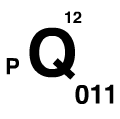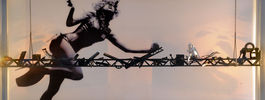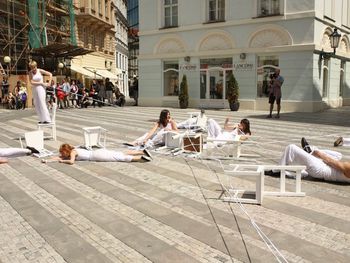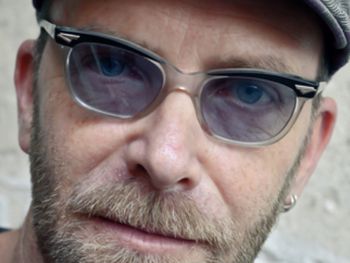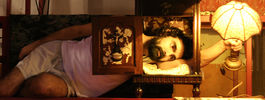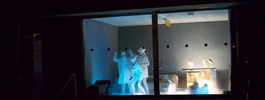In the life of the theatre, cinema, television, and other forms of stage creativity important changes are taking place, and mutual relations and understandings are being altered. New forms of narration, and its place, are being sought and chosen. The stage is moving nearer to the public, and the audience is being introduced into the play and becomes a sort of collaborator. Thus the audience is becoming increasingly responsible for the final impression of the performance. In this way, everything becomes a stage, or simply a space for a certain happening, whereby scenography, costumes and masks have to follow carefully all changes and desires. Modern scenography is a play of „wide facets" and compressed forms. With the condensation of idea, space and time, the color and the form are linked essentially to the concept of the performance. To find the most important feature of a play, to find the corresponding space for the achievement of the scenic idea, and to perform the artistic transformation of the stage, it is necessary to penetrate into the very structure of the play, into the personal approach of the director, and to connect and submit all these to the basic idea and procedure. It seems that Yugoslav stage and costume designers are well acquainted with innovations that are appearing and „splashing" modern stage and costume designs. Permanent and essential changes and experiments are taking place all over the world. Stages obtain new values in artistic beauty and space content. The whole of theatrical life exists, more or less, under the sign of constant changes, transformations and contradictions. Yugoslav artists have a lively and in fact passionate interest in all new trends, which they follow closely not only as far as the modern theatre and cinema are concerned, but also all areas of creativity, particularly those connected with the theatre: painting, sculpture, architecture, photography, fashion, industrial design, etc. Constantly seeking unusual forms of expression and introducing innovations, they demonstrate their own artistic incentives, their inspirations. The roads followed by Yugoslav stage and costume designs are numerous and significant. This will be easily confirmed at the Prague Quadrennial 1983. However, financial difficulties and stabilization measures have imposed a more rational use of means and materials. Thus ideas have become simplified and more sparing. Therefore we always have to consider how it is possible to build into these simplified spaces a play, which is highly committed and how the experience of other theatre creators (actors, musicians, etc.) can be utilized. We are faced with a crisis that does not encompass only those who create for the stage, but also those who have to accept and understand what we are doing.
- Geroslav Zarić
Milutovac
Additional information: Born in 1951 in Milutovac (Serbia). He works as a stage designer with numerous theatres in Belgrade and also for television.
Obrázky z katalogu
Exhibiting works
-
: (The Hobbit),
(Boško Buha Beograd),
1982, Director: P. Magelli,
- Miodrag Tabacki
Specialization: set designer
Additional information: Born in 1947. He works as a stage and costume designer with a number of different Yugoslav theatres. He also lectures at the Faculty of Drama Arts in Belgrade. He exhibited at the PQ in 1979.
Obrázky z katalogu
Exhibiting works
-
: (A Step — A Round Dance),
(Centar Sava Beograd),
1980, Director: M. Mišković,
- Milanka Berberović
* 1942, Schabats
Specialization: teacher, set designer, costume designer
Additional information: Costume designer, since 1982 professor at the Costume Design Department of the Faculty of Applied Arts in Belegrade. She participated in the Prague Quadrennial 1983 and 1987.
Information from catalogue 1999:
Graduated from the Faculty of Applied Arts in Beograd. Currently co-operates as a costume designer with various Yugoslavian theatres, including National Theatre and Drama Theatre in Beograd. She works as a professor at the Faculty of Applied Arts and Design, Beograd. From 1971 to 1991, she participated in all the PQs. She is the winner of a Silver Medal at the International Triennal Exhibition, Belgrade 1995.
She is well-known with creative and functional costume solutions. Her sketches and pictures of costumes are extremely meticulous.
Exhibiting works
-
: (Accidental Death of an Anarchist),
(Beogradsko Dramsko Pozorište),
1981, Director: S. Saletovič,
-
: (A Suspicious Person ),
(Beogradsko Dramsko Pozorište),
1982, Director: A. Ognjanovič,
- Miomir Denic
Additional information: Born in 1913 in Belgrade. Professional training at the studios of two art-painters — prof. M. Petrovič and prof. J. Bijelič. In 1934 he completed his studies at the Academy of Theatre Art in Belgrade. As painter and stage designer he made his first appearance in 1936 at the National Theatre in Belgrade. Between 1944 and 1950 he acted as the artistic chief at the Central Studio of the Yugoslav film. He has brought into effect about 650 stage sets form dramas, operas and ballets, and scenic dispositions for some fifty films. Abroad he scored a great success as the creator of a specific style for grand Slav operas — for works by Tchaikovski, by Prokofiev, by Borodine, by Rimski-Korsakov, by Moussorgski, and for Káťa Kabanová by Janáček, which he has put on the stage in Munich, Athens, Barcelona, Rome, Palermo, Catania, Genoa, Ferrara, Modena, Trieste, Sofia, Cairo and in other towns. He was awarded the Prize of Sterijino Pozorje in 1964 and 1969, the prize for the best scenic realization in 1968 and 1970. He was awarded the Prize of the Federation in 1949 and the Gold Arena of Apulia in 1957, 1958 and in 1963 for various films. He gives himself up intensively to problems of architecture and to the improvement of the film and theatre technique. He took part in the construction of the first film studio in Yugoslavia and originated several experimental and open-air scenes. Resently he has brought into being the Municipal Theatre Circle 101 having been inaugurated on December lOth, 1970.
Obrázky z katalogu
Exhibiting works
-
: (Falstaff),
(Narodno Pozorište Beograd),
1979, Director: M. Sabljič,
- Branko Kostovski
Additional information: Born in 1924 in Skoplje. Since 1952 he has been working as a stage designer at the Macedonian Popular Theatre in Skoplje. He participated in the PQ in 1967, 1971, 1975 and in 1979.
Obrázky z katalogu
Exhibiting works
-
: (The Alexiad),
(Makedonsko Narodno Pozorište Skoplje),
1980, Director: V. Milčin,
-
: (Couch Grass),
(Narodno Pozorište Bitola),
1981, Director: V. Milčin,
- Vladislav Lalicki
Additional information: Born in 1935 in Shabats. Since 1962 he has been working as a stage designer at the Yugoslav Drama Theatre in Belgrade. He participated in the PQ in 1967.
Obrázky z katalogu
Exhibiting works
-
: (Banović Strahinja),
(Narodno Pozorište Beograd),
1980, Director: L. Pilipenková,
-
: (The Ohrid Legend),
(Srpsko Narodno Pozorište Novi Sad),
1980, Director: V. Kostičová,
-
: (Country Srpsko),
(Narodno Pozorište Novi Sad),
0, Director: D. Mijač,
- Mileta Leskovac
Additional information: Born in 1924. Graduated from the School of Applied Arts at Novi Sad. He has brought into effect over 100 stage designs the most important of which are sets for the following plays: Ridiculous Precious by J. S. Popovic, Nora by H. Ibsen, The Dancing Dorisa by K. Odak, The Heretic by St. Mras, Never Satisfied by K. Trifkovič, Twelfth Night by W. Shakespeare, A Moon for the Misbegotten by 0'Neill, Big Mack by E. Kosch. He took part in the international exhibition of stage design in Zurich. He was awarded the Municipality Prize of Novi Sad for his sets to the play by K. Trifkovič. He is at work as stage designer of the Serbian National Theatre at Novi Sad.
Obrázky z katalogu
Exhibiting works
-
: (Carmen),
(Narodno Pozorište Sarajevo),
1981, Director: D. Miladinović,
- Vladimir Marenić
Additional information: Born in 1921 at Slavonska Pozega. Studied scenic design under prof. Milenko Serban and painting under prof. Ivan Tabaković. He is at work as stage and costume designer of the National Theatre in Belgrade. He has designed more than 170 stage sets and some 35 theatre costumes. Exhibited in Yugoslavia and abroad. His most important works include scenic designs to The Celestial Squad by Lebović and Obrenović, Rose Tattoo by Tennessee Wiliams, Nabucco and Aida by G. Verdi, Halleluyah by D. Lebovič, to the opera Mazeppa by P. I. Tchaikovsky, to Becket by J. Anouilh, The Life for the Tsar renamed to Ivan Susanin by M. I. Glinka, Rabelais by J. L. Barrault, etc. In his artistic realizations he employs different painting techniques. He was awarded tihe Sterijino Pozorje Prize for The Celestial Squad in 1957, the ULUPUS Prize for scenographic designs in 1965 and 1968, the October Salon Prize for stage sets to Master Hanus in 1966, the Prize having been attributed on occasion of 100 Years of the Belgrade National Theatre for sets to the play Swindle in 1969, the Prize of the Voyvodina Theatres Meeting for sets to the play The Devil's Disciple in 1970.
Obrázky z katalogu
Exhibiting works
-
: (Macbeth),
(Beograd Opera),
1981, Director: M. Sabljić,
-
: (Great Preparation),
(Free Group Novi Sad),
1980, Director: B. Ruškuc,
- Drago Turina
* 1943, Virje
Specialization: set designer
Additional information: Born in 1943. He started his work as stage and costume designer in students' amateur theatres during his studies at the faculty of machinery and naval architecture. At present he acts as stage designer at the Zagreb profesional theatres and in the film production. In a review having been stated by yong writers and artists he publishes articles on the theory and practical problems of modern stage design art. He has been awarded several prizes at theatre festivals for a succesful experímental work in the special field of stage design concerns.
He works as a stage designer at the Branko Gavella Theatre in Zagreb. He participated in the PQ in 1971 and in 1975.
Exhibiting works
-
: (The Croatian Faustus),
(Hrvatsko Narodno Kazalište Split),
1982, Director: D. Radojević,
- Boris ČERŠKOV
Additional information: Born in 1932 in Stobrech near Split. Since 1956 he has been working as a stage and costume designer at the National Theatre in Nish. He participated in the PQ in 1975.
Obrázky z katalogu
Exhibiting works
-
: (King Lear),
(Narodno Pozorište Niš),
1982, Director: M. Radisavljevič,
- Zoran RISTIČ
Additional information: Born in 1942 in Belgrade. He works at the Belgrade Drama Theatre.
Obrázky z katalogu
Exhibiting works
-
: (Harold and Maud Beogradsko Dramsko Pozorište 1980 r. P. Magelli),
(Beogradsko Dramsko Pozorište),
1980, Director: P. Magelli,
- Aleksandar ZLATOVIČ
Additional information: Born in 1949 in Belgrade.He graduated from the Faculty of Applied Arts. Currently operates as a stage and costume designer in National Theatre in Beograd and with other theatres throughout Yugoslavia. In 1983, 1987 and 1991 he participated in the PQ.
Obrázky z katalogu
Exhibiting works
-
: (The Miser),
(Primorsko Dramsko Gledališče Nova Gorica),
1982, Director: R. Dorić,
- Velizar SRBLJANOVIĆ
Additional information: Born in 1928. He works at the Belgrade Drama Theatre.
Obrázky z katalogu
Exhibiting works
-
: (The Saint Andrew Rhapsody),
(Beogradsko Dramsko Pozorište),
1983, Director: M. Lazin,
- Ana Atanackovičová
Obrázky z katalogu
Exhibiting works
-
: (The Mandrake),
(Hrvatsko Narodno Kazalište Osijek),
1981, Director: D. Bibanović,
- Alenka Bartlová-Převoršeková
* 1930, Lublaň
Specialization: teacher, costume designer
Obrázky z katalogu
Exhibiting works
-
: (The Kindly Boor),
(Slovensko Narodno Gledališče Ljubljana),
1982, Director: M. Herzog,
- Marika Dančová-Rothová
Obrázky z katalogu
Exhibiting works
-
: (The Chairs),
(Eksperimentalno Gledališče Glej),
1982, Director: J. Souček,
- Sanja Džeba
Obrázky z katalogu
Exhibiting works
-
: (Ubu the King),
(Narodno Pozorište Tuzla),
1982, Director: D. Bibanovič,
-
: (The Mandrake),
(Narodno Pozorište Tuzla),
1982, Director: D. Bibanovič,
- Mara Finciová
Obrázky z katalogu
Exhibiting works
-
: (Macbeth),
(Narodno Pozorište Osijek),
1980, Director: P. Teslić,
- Mija Jarčová
Obrázky z katalogu
Exhibiting works
-
: (The Seagull),
(Slovensko Narodno Gledališče Ljubljana),
1982, Director: D. Mlakar,
-
: (One Month in the Country),
(Slovensko Narodno Gledališče Nova Gorica),
1981, Director: D. Mlakar,
- Milena Jeftičová-Ničevová
Obrázky z katalogu
Exhibiting works
-
: (Adam and Eve),
(Narodno Pozorište Sarajevo),
1981, Director: S. Pervan,
- Božana Jovanovičová
Obrázky z katalogu
Exhibiting works
-
: (King Lear),
(Jugoslovensko Dramsko Pozorište Beograd),
1979, Director: P. Magelli,
- Ljerka Kalčičová
Obrázky z katalogu
Exhibiting works
-
: (The Magnificent Cuckold),
(Narodno Pozorište Beograd),
1981, Director: B. Grigorović,
-
: (Twentieth Century Orpheus),
(Narodno Pozorište Beograd),
1981, Director: D. Miladinović,
- Milena Kumarová
Obrázky z katalogu
Exhibiting works
-
: (Don Juan and Faust),
(Slovensko Narodno Gledališče Maribor),
1980, Director: J. Babić,
- Mirjana Markovičová
Obrázky z katalogu
Exhibiting works
-
: (Stanoje Glavaš),
(Joakim Vujić Pozorište Kragujevac),
1982, Director: P. Govedarević,
- Cveta Mirniková
Obrázky z katalogu
Exhibiting works
-
: (Open the Door, Oscar is Coming),
(Slovensko Narodno Gledališče Celje),
1980, Director: D. Mlakar,
-
: (Each In His Own Way),
(Slovensko Narodno Gledališče Nova Gorica),
1978, Director: D. Mlakar,
- Jasna Novaková
Obrázky z katalogu
Exhibiting works
-
: (The Conqueror),
(Kazalište Branko Gavella Zagreb),
1979, Director: D. Radojević,
- Snežana Petrovićová
Obrázky z katalogu
Exhibiting works
-
: (An Old Woman Brooding),
(Narodno Pozorište Kikinda),
1982, Director: M. Duškov,
- Mihailo Simidrijević
Obrázky z katalogu
Exhibiting works
-
: (The Wreck of the Titanic),
(Teatar Poezije Beograd),
1981, Director: U. Glovacki,
- Dagmar Stojanovićová
Obrázky z katalogu
Exhibiting works
-
: (Hostelry),
(Beogradsko Dramsko Pozorište),
1980, Director: M. Maričić,
- Helena Volfartová-Kojovičová
Obrázky z katalogu
Exhibiting works
-
: (The Uprising of the Coquins),
(Narodno Pozorište Bosanske Krajine Banja Luka),
1979, Director: B. Jerković,
-
: (The Great Vizier),
(Narodno Pozorište Sarajevo),
1981, Director: S. Kupusović,
- Melita Vovková
Obrázky z katalogu
Exhibiting works
-
: (Hands Around),
(Slovensko Narodno Gledališče Celje),
1982, Director: F. Križaj,
- Djordji Zdravev
Obrázky z katalogu
Exhibiting works
-
: (Flying on the Spot),
(Dom na Mladite 25 Maj Skoplje),
1982, Director: S. Unkovski,
- Zora Živadinovičová-Davidovičová
Obrázky z katalogu
Exhibiting works
-
: (Tashana),
(Bora Stanković Vranje),
1982, Director: R. Radivojević,
- Milica RADOVANOVIĆ (Milica Radovanović)
Specialization: costume designer
Additional information: Born 1942 in Belgrade. She cooperates as costume designer particulary with the Belgrade
National Theatre. She participated in the Prague Quadrennial 1983 and 1987.
Exhibiting works
-
: (Joakim Vujić),
(Beogradsko Dramsko Pozorište Beograd),
1979, Director: M. Dědić,

